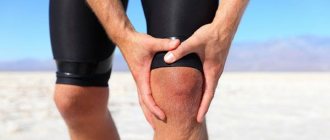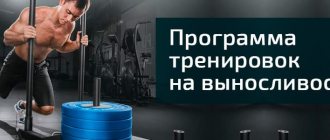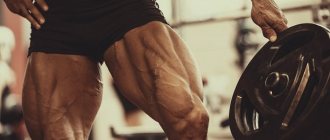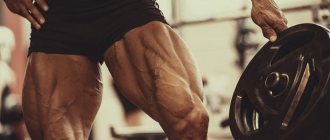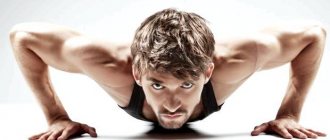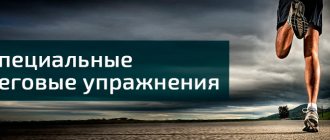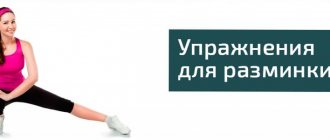Gonarthrosis is not a reason to give up physical activity. Quite the opposite: lack of movement will quickly lead to stagnation in the joint, which means the situation will only worsen. There are simple sets of exercises that are allowed for people undergoing treatment for osteoarthritis. You can start doing them only after taking painkillers. If pain makes itself felt, training should be postponed.
Exercise strengthens the tissue around the knee joint
What should you expect from exercise?
It is a mistake to think that physical therapy for arthrosis of the knee joint can work wonders and completely restore health. If there are irreversible changes in the knees, the problem can be radically solved only with the help of implants. But the operation is not cheap and is not suitable for everyone. Therefore, exercises to develop the knee joint are often the only option to alleviate the condition and improve the patient’s well-being.
With their help you can:
- relieve pain symptoms;
- restore blood circulation in the problem area;
- achieve long-term remission;
- strengthen muscles;
- increase joint mobility;
- improve overall well-being.
You should not expect relief to come after the first session: the results of exercise therapy for knee arthrosis will be noticeable after several weeks of training. However, this is not a reason to relax, because only regular, measured and correct loads can restore the function of the knees. Exercise for arthrosis of the knee joint should become a mandatory daily ritual for those who do not want the disease to worsen.
Features of Dr. Bubnovsky’s technique
S. Bubnovsky is a famous chiropractor, the author of the method of kinesitherapy, or movement treatment. Before conducting the first classes, rehabilitation doctors from the medical centers he founded explain to patients the meaning of the upcoming therapy.
All pathologies of the knee joint cause gradual destruction of the cartilage lining. Its damage is caused by disruption of tissue nutrition. Since cartilage does not have a circulatory system, it receives the necessary substances through osmosis (one-way diffusion) from the synovial fluid. So far, no drugs have been developed that would provide adequate nutrition for cartilage. This is only possible through frequently repeated movements. When the joint is extended, as a result of the pressure difference, a sufficient amount of nutrients is supplied to the cartilage tissue for their regeneration.
Principles of exercise therapy for arthrosis
A set of exercises for knee pain is not a panacea, but it still gives good results. But provided that patients strictly follow the specialist’s instructions and adhere to certain principles.
During classes, you should not make sudden movements, even if they are part of a rehabilitation program. An awkward turn or bend can aggravate the situation and cause serious problems with the musculoskeletal system. Although knee extension exercises are a mandatory part of rehabilitation, they should be avoided if pain occurs. If your knee hurts, it means that the physical activity was calculated incorrectly.
Classes should be regular, ideally daily. This is the only way to achieve results and strengthen the muscles of the knee joint. They are what keep the knee in the correct position and ensure its functionality.
Despite the regularity of exercise, physical activity for arthrosis of the knee joint should be small. Therefore, it is very important to alternate exercises with rest, and also to perform the bulk of the exercises for the knee joints in a sitting or lying position. It is important to ensure that the spine remains straight during exercise.
Quadriceps Anatomy
The rectus femoris is a unique muscle because it affects both the knee and hip joints. Increasing stability in a deep squat, combating knee pain, or finally finding the key to running faster sprints with more knee movement all depend heavily on the strength and proper functioning of this muscle. This muscle may be more difficult to train, but these workouts will be both beneficial and very necessary.
The quadriceps are made up of four “heads”:
- Rectus femoris muscle . The longest of the four. Located on the front of the thigh. The upper edge is attached to the ilium, the lower edge passes into the common tendon of the quadriceps muscle. Goal : hip flexion, leg extension;
- Greater medial femoris muscle . Located in the anteromedial part of the thigh. One edge is attached to the upper part of the thigh, the other goes into the common tendon of the thigh. Goal : extension of the lower leg;
- Vastus lateralis muscle . Located on the anterolateral part of the thigh. The upper edge is attached to the trochanter of the femur, the lower edge passes into the common tendon of the femur. Goal : extension of the lower leg;
- Vastus intermedius muscle. Located directly under the rectus femoris muscle. One edge is attached to the upper part of the thigh, the other goes into the common tendon of the thigh. Goal: extension of the lower leg.
How the training goes
At the initial stage of exercise therapy, exercises for the knee joint are performed exclusively under the supervision of a specialist. Typically, a workout lasts no more than 60 minutes, of which half the time is spent warming up the muscles. This is very important because the muscles and ligaments must be prepared. For older people, who most often experience arthrosis and, as a rule, cannot boast of muscle elasticity, warm-up can take more than half an hour.
Since when performing exercises for the treatment of arthrosis of the knee joint, the load on problem areas must be dosed, the main part of the training takes place lying down or sitting. Therefore, you should prepare a sports mat in advance. Chairs with hard backs are often used during classes.
As the muscles strengthen, the load on the legs increases. If the patient is in good physical shape, he performs at least 30–50 exercises in one approach, and the number of approaches can reach 3–5 per workout. However, after each approach the body must be given rest. Pauses are usually used to relax muscles and perform breathing exercises.
Indications for use
Gymnastics according to Bubnovsky is used as a method of treating any inflammatory and degenerative diseases of the knee joints. These are deforming arthrosis, gout, rheumatoid arthritis, chronic bursitis, synovitis, tendinitis, tendovaginitis. Excellent results are shown by training for pathologies of 1-2 degrees. But even with severe deformation of the cartilage and bone structures of the knee, an increase in the range of movements and the disappearance of flexion and extension contractures are observed.
Regular training helps patients recover faster after endoprosthetics, meniscal, ligament, tendon, and intra-articular fractures.
What is important to pay attention to
Since training should be daily, classes can be done at home. But only after the basic sets of exercises have been completed under the guidance of a specialist. It is the LKF trainer who must determine the loads and make recommendations for those who want to perform joint exercises for arthrosis of the knee joint at home.
Loads are determined individually, taking into account:
- age;
- general well-being;
- level of physical fitness;
- degree of damage to the knee joint;
- presence of diseases.
Those who train independently still need to periodically attend general training sessions in order to adjust the load and learn new exercises. It is important to remember that the duration of exercise is not determined by health status. There are often cases when refusal of exercise therapy with visible improvement led to exacerbation of arthrosis. That is, you need to be prepared for the fact that physical therapy will now become an integral part of the life of a patient with arthrosis.
Positive and negative sides
One of the main advantages of Bubnovsky’s gymnastics is the impact not only on the symptoms of pathologies, but also on the cause of their development. Regular training helps provide the soft, cartilage, and bone structures of the knee joint with nutrients. First, degenerative, chronic inflammatory processes slow down and then completely stop. In young people, partial restoration of damaged tissue is possible. And middle-aged and elderly patients notice that now even intense movement does not lead to painful sensations.
S. Bubnovsky’s method has one drawback - the need to practice while overcoming pain. But gradually its severity decreases, and soon training brings only pleasure. A person feels that his muscles have become strong and his ligaments are elastic. I gained confidence when moving, my posture and gait improved, and other chronic diseases subsided.
The most popular exercises for knee arthrosis
Any set of exercises for arthrosis of the knee joint consists of two large groups of exercises. The first are performed in a lying position, the second - while sitting. It is recommended to do the following daily while lying down:
- Bike. The exercise is performed on your back and simulates riding a bicycle. In this case, the legs should be bent at the knees at a right angle.
- Leg bending. You should lie on your back and alternately bend your knees, pulling them as close to your chest as possible.
- Stretching the muscles of the knee joint. You need to lie on your stomach and simultaneously bend your knees, trying to touch your buttocks with your heels.
Such exercises do not require special physical training, but can cause discomfort. Gradually, the knee muscles will strengthen, allowing you to increase the load. The best option is to perform at least 3 approaches in one session, each approach can include repeating the exercise up to 50 times. You should also not ignore the complex designed for sitting exercises. It includes exercises such as:
- Pulling your knees to your chest. You need to sit on a chair with a hard back, lean on it, and then grab one leg at the knee and try to pull it as close to your chest as possible. Then do the same with the other leg, then pull both legs bent at the knees to your chest.
- Pumping muscles. You should place your hands on your knees and lightly press them down, fix them. Then try to tighten your hips as much as possible, making sure to keep your knees still. You need to spend at least 30 seconds in tension, then relax and repeat the exercise again.
- Scissors. This exercise is best performed while sitting on the floor. It is best to fold your arms across your chest: you cannot lean on them. The back should be straight, but without support from the wall or any other vertical object.
You should straighten your spine and try to spread your legs to the sides without touching the floor. The distance to it should be 5–10 cm, then the legs should be brought together. When you can do this exercise quite easily, you should try to cross your legs in the air, imitating scissors.
Many people wonder whether it is possible to squat with arthrosis of the knee joint. There is no consensus on this matter, because any squats put increased stress on the knees and can aggravate the situation. On the other hand, the leg muscles need to be gradually strengthened, and without physical activity this is impossible. Therefore, many experts still recommend performing squats for arthrosis of the knee joint, but in such a way that the center of gravity of the body is shifted. This effect can be achieved if, for example, you hold on to a wall or chair while performing the exercise, which minimizes the load on your knees. But before introducing this seemingly simple exercise into your daily training, you should consult with a physical therapy trainer.
The effectiveness of physical therapy
Physical therapy exercises should be regular. It is therapeutically more effective to exercise 15-30 minutes daily than 2-3 hours a week. This is explained by the gradual adaptation of muscles to the resulting loads.
During exercise, you need to listen to the sensations that arise. Mild muscle discomfort is allowed. But if it is replaced by pain, then you need to interrupt the workout and rest. And exercises, after which you feel better and stiffness disappears, can be done with a large number of approaches.
Use gymnastics wisely, and it will certainly give results.
Are there any restrictions for playing sports with knee arthrosis?
It would seem that physical therapy should be suitable for everyone who wants to improve their health without resorting to surgery. But exercises to strengthen the knee ligaments are not recommended for everyone. They are not recommended to be performed if you feel unwell and have increased pain in your knees, fever, cold, or high blood pressure. You should not exercise forcefully during exacerbation of any chronic diseases.
Very often, supporters of an active lifestyle try to combine exercise therapy with other sports. Experts recommend paying attention to swimming and cycling at a moderate pace, without serious stress on the knees. But you will have to completely abandon skis and skates. If you have arthrosis of the knees, running is contraindicated, which can be successfully replaced by Nordic walking. You should also not practice strength training with heavy lifting. You will have to give up any types of martial arts, football, hockey, volleyball, where the load on the legs is increased, you need to jump and perform sudden movements. In addition, these sports have a fairly high incidence of injuries, which is unacceptable with knee arthrosis. But yoga, Pilates and stretching with muscle stretching exercises will be very useful.
Preparation
At S. Bubnovsky’s medical centers, during the preparation stage, the patient visits a full-time psychologist. The purpose of group classes is to gain self-confidence and mobilize to fight the disease. The patient is also taught the technique of deep diaphragmatic breathing. This allows you to increase the therapeutic effect of training by providing all vital systems with oxygen.
At home, you need to ventilate the room 10-15 minutes before class. But it shouldn’t be cold in it, otherwise there is a risk of hypothermia and muscle inflammation. Clothes for training should be loose-fitting, do not restrict movement, absorb moisture well and allow air to pass through.
